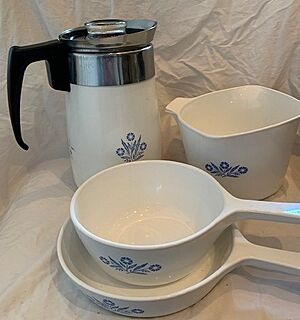CorningWare facts for kids
CorningWare is a special type of cookware that can handle big changes in temperature. It's made from a unique material called glass-ceramic, also known as Pyroceram. This means you can take it from the freezer or fridge and put it straight onto the stove, into an oven, or even a microwave! It was first made in 1958 by Corning Glass Works in the United States. Today, it's sold by Corelle Brands and is popular all around the world, especially in North America, Asia, and Australia.
Contents
History of CorningWare
How Pyroceram was Discovered
In 1953, a scientist named S. Donald Stookey at Corning Glass Works made an amazing discovery by accident. He was working with a special type of glass. One day, he put a piece of this glass into a very hot oven. When he checked, the oven was much hotter than he planned! The glass had turned a milky white color. When he tried to pick it up, it slipped and fell to the floor, but it didn't break! This super-strong material was named Pyroceram.
Pyroceram was first used for important things like ballistic missiles. It helped protect the nose cones of missiles from extreme heat.
CorningWare in the US
CorningWare made from Pyroceram was first produced mainly in the United States. However, production in the US stopped in 2001 when a factory closed. For a while, you couldn't buy the original Pyroceram CorningWare in the US.
The company, then called "World Kitchen," decided to stop making some products. They wanted to lower costs and use their factories better.
But good news! In December 2008, the Pyroceram-based CorningWare came back to the US. It was called CorningWare StoveTop. This cookware is now made in France. Modern Pyroceram production is even better because it doesn't use arsenic.
In early 2022, sales of this CorningWare were paused in the USA. But it reappeared on the market in early 2023. It is still sold in many other parts of the world.
CorningWare Designs and Products
The very first design for CorningWare was called 'Wheat'. It was tested in 1958 but wasn't very popular. So, they switched to the 'Blue Cornflower' design. This design was created by Joseph Baum. The 'Blue Cornflower' became the most famous symbol for Corning products for 30 years! Many other designs have been made too, like 'Floral Bouquet', 'Spice O' Life', 'French White', and 'Shadow Iris'.
Today, Pyroceram-based CorningWare is very popular in Asia and Australia. Many new designs have been created just for these areas. Some of these include Bliss, Blue Elegance, Cool Pansies, and Country Rose.
The lids for CorningWare are usually made of Pyrex. While some very old lids were made of Pyroceram, most newer ones are made of different types of glass. These lids can't handle direct heat as well as the cookware itself.
Over 750 million pieces of CorningWare have been made since it started! This includes many different items. You can find casserole dishes, coffee pots, frying pans, saucepans, and even pie plates.
Other Similar Products
Corelle Brands also sells products that look like CorningWare. But these are made of glazed stoneware, not Pyroceram. The packaging for these items clearly states they are not for stovetop use.
Visions is another brand of transparent cookware. It was first made by Corning in France. Visions cookware is made from a clear version of Pyroceram. It has similar heat-resistant qualities to CorningWare. It also resists stains and damage from acids and detergents better.
Corelle is a brand known for its strong, break-resistant dishware. Corelle has offered designs that match many CorningWare patterns. It's important to know that CorningWare cookware and Corelle dishes are different. They have different properties when it comes to heat.
Other companies also sell cookware similar to CorningWare. For example, Arc International in France sells cookware under names like Arcoflam and Luminarc. Some of their white glass-ceramic cookware has even been sold under the CorningWare brand name.
Images for kids




